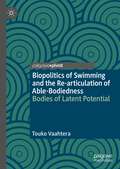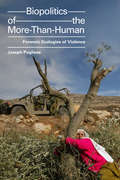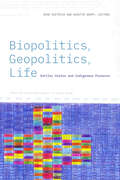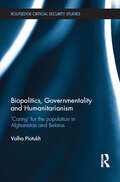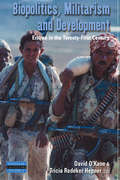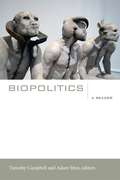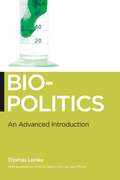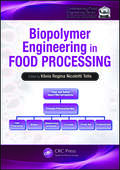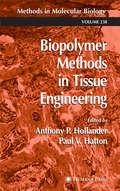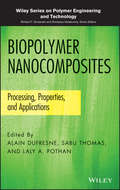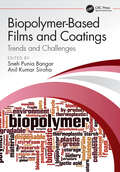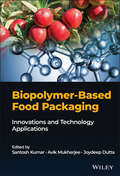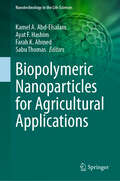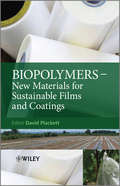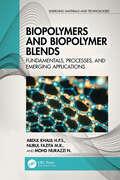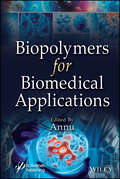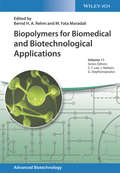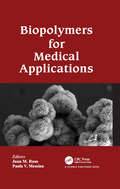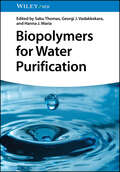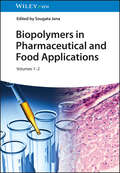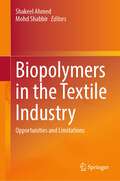- Table View
- List View
Biopolitics of Swimming and the Re-articulation of Able-Bodiedness: Bodies of Latent Potential
by Touko VaahteraIn this book, Touko Vaahtera explores how “bodies of latent potential,” a cultural attachment to the idea of body as potentiality, carries with it hierarchizing hopes about better bodies. Vaahtera combines disability studies, cultural studies, feminist science studies, transgender studies, post-colonial studies, and Foucauldian genealogy to offer a provocative approach that interrogates capacities and capabilities as obvious frameworks for thinking about the body. Vaahtera explores how swimming skills emerged as a specific biopolitical question in Finland, a country that has been described as the “Land of a Thousand Lakes.” Through a profound cultural analysis focusing both on Finnish cultural texts on swimming as well as manifold more globalized texts, Vaahtera considers how the legacy of eugenics and colonialism, the hopes of civilization, and homogenizing assumptions about bodies frame how we think about human capacity.
Biopolitics of the More-Than-Human: Forensic Ecologies of Violence (ANIMA: Critical Race Studies Otherwise)
by Joseph PuglieseIn Biopolitics of the More-Than-Human Joseph Pugliese examines the concept of the biopolitical through a nonanthropocentric lens, arguing that more-than-human entities—from soil and orchards to animals and water—are actors and agents in their own right with legitimate claims to justice. Examining occupied Palestine, Guantánamo, and sites of US drone strikes in Afghanistan, Pakistan, Somalia, and Yemen, Pugliese challenges notions of human exceptionalism by arguing that more-than-human victims of war and colonialism are entangled with and subject to the same violent biopolitical regimes as humans. He also draws on Indigenous epistemologies that invest more-than-human entities with judicial standing to argue for an ethico-legal framework that will enable the realization of ecological justice. Bringing the more-than-human world into the purview of justice, Pugliese makes visible the ecological effects of human war that would otherwise remain outside the domains of biopolitics and law.
Biopolitics, Geopolitics, Life: Settler States and Indigenous Presence
by René Dietrich and Kerstin KnopfThe contributors to Biopolitics, Geopolitics, Life investigate biopolitics and geopolitics as two distinct yet entangled techniques of settler-colonial states across the globe, from the Americas and Hawai‘i to Australia and Aotearoa/New Zealand. Drawing on literary and cultural studies, social sciences, political theory, visual culture, and film studies, they show how biopolitics and geopolitics produce norms of social life and land use that delegitimize and target Indigenous bodies, lives, lands, and political formations. Among other topics, the contributors explore the representations of sexual violence against Native women in literature, Indigenous critiques of the carceral state in North America, Indigenous elders’ refusal of dominant formulations of aging, the governance of Indigenous peoples in Guyana, the displacement of Guaraní in Brazil, and the 2016 rule to formally acknowledge a government-to-government relationship between the US federal government and the Native Hawaiian community. Throughout, the contributors contend that Indigenous life and practices cannot be contained and defined by the racialization and dispossession of settler colonialism, thereby pointing to the transformative potential of an Indigenous-centered decolonization. Contributors René Dietrich, Jacqueline Fear-Segal, Mishuana Goeman, Alyosha Goldstein, Sandy Grande, Michael R. Griffiths, Shona N. Jackson, Kerstin Knopf, Sabine N. Meyer, Robert Nichols, Mark Rifkin, David Uahikeaikaleiʻohu Maile
Biopolitics, Governmentality and Humanitarianism: 'Caring' for the Population in Afghanistan and Belarus (Routledge Critical Security Studies)
by Volha PiotukhThis book critically analyses the changing role and nature of post-Cold War humanitarianism, using Foucault's theories of biopolitics and governmentality. It offers a compelling and insightful interpretation of the policies and practices associated with ‘new humanitarianism in general, as well as of the dynamics of two specific international assistance efforts: the post-2001 conflict-related assistance effort in Afghanistan and the post-2000 Chernobyl-related assistance effort in Belarus. The central argument of the book is that ‘new’ humanitarianism represents a dominant regime of humanitarian governing informed by globalising neoliberalism and is reliant on a complex set of biopolitical, disciplinary and sovereign technologies. It demonstrates that, while the purposes of humanitarian governing are specific to particular contexts, its promise of care is more often than not accompanied by sovereign and/or biopolitical violences. Making an important contribution to existing scholarship on humanitarian emergencies and humanitarian action, on biopolitics and governmentality, this book will be of much interest to students and scholars of humanitarianism, critical security studies, governmentality and International Relations generally.
Biopolitics, Militarism, and Development: Eritrea in the Twenty-First Century (Dislocations #6)
by Tricia Redeker Hepner David O'KaneBringing together original, contemporary ethnographic research on the Northeast African state of Eritrea, this book shows how biopolitics - the state-led deployment of disciplinary technologies on individuals and population groups - is assuming particular forms in the twenty-first century. Once hailed as the “African country that works,” Eritrea’s apparently successful post-independence development has since lapsed into economic crisis and severe human rights violations. This is due not only to the border war with Ethiopia that began in 1998, but is also the result of discernible tendencies in the “high modernist” style of social mobilization for development first adopted by the Eritrean government during the liberation struggle (1961–1991) and later carried into the post-independence era. The contributions to this volume reveal and interpret the links between development and developmentalist ideologies, intensifying militarism, and the controlling and disciplining of human lives and bodies by state institutions, policies, and discourses. Also assessed are the multiple consequences of these policies for the Eritrean people and the ways in which such policies are resisted or subverted. This insightful, comparative volume places the Eritrean case in a broader global and transnational context.
Biopolitics: A Reader
by Adam Sitze Timothy CampbellThis anthology collects the texts that defined the concept of biopolitics that has become so significant throughout the humanities and social sciences today. The far-reaching influence of the biopolitical - the relation of politics to life, or the state to the body - is not surprising given its centrality to matters such as healthcare, abortion, immigration, and the global distribution of essential medicines and medical technologies.
Biopolitics: An Advanced Introduction (Biopolitics #5)
by Thomas LemkeThe first systematic overview of the notion of biopolitics and its relevance in contemporary theoretical debateThe biological features of human beings are now measured, observed, and understood in ways never before thought possible, defining norms, establishing standards, and determining average values of human life. While the notion of “biopolitics” has been linked to everything from rational decision-making and the democratic organization of social life to eugenics and racism, Thomas Lemke offers the very first systematic overview of the history of the notion of biopolitics, exploring its relevance in contemporary theoretical debates and providing a much needed primer on the topic. Lemke explains that life has become an independent, objective and measurable factor as well as a collective reality that can be separated from concrete living beings and the singularity of individual experience. He shows how our understanding of the processes of life, the organizing of populations and the need to “govern” individuals and collectives lead to practices of correction, exclusion, normalization, and disciplining. In this lucidly written book, Lemke outlines the stakes and the debates surrounding biopolitics, providing a systematic overview of the history of the notion and making clear its relevance for sociological and contemporary theoretical debates.
Biopolitics: Bioethics And Biopolitics (International Library Of Ethics, Law, And The New Medicine Ser. #49)
by Catherine MillsThe concept of biopolitics has been one of the most important and widely used in recent years in disciplines across the humanities and social sciences. In Biopolitics, Mills provides a wide-ranging and insightful introduction to the field of biopolitical studies. The first part of the book provides a much-needed philosophical introduction to key theoretical approaches to the concept in contemporary usage. This includes discussions of the work of Michel Foucault, Giorgio Agamben, Hannah Arendt, Roberto Esposito, and Antonio Negri. In the second part of the book, Mills discusses various topics across the categories of politics, life and subjectivity. These include questions of sovereignty and governmentality, violence, rights, technology, reproduction, race, and sexual difference. This book will be an indispensable guide for those wishing to gain an understanding of the central theories and issues in biopolitical studies. For those already working with the concept of biopolitics, it provides challenging and provocative insights and argues for a ground-breaking reorientation of the field.
Biopolitiken – Regierungen des Lebens heute: Regierungen Des Lebens Heute (Politologische Aufklärung – konstruktivistische Perspektiven)
by Helene Gerhards Kathrin BraunDas Buch versammelt konstruktivistische Perspektiven auf das Konzept „Biopolitik“. Dadurch werden die Analysepotentiale für aktuelle Phänomene, die den Zusammenhang zwischen dem Leben und dem Lebendigen und der Regierbarmachung betreffen, ausgelotet. Im Fokus stehen die Strategien und die Objekte der Regierungs- und Regulierungsbemühungen: In welcher Weise werden gesellschaftliche Probleme konstruiert und bestimmten „Zielscheiben“ zugeschrieben? Welche Subjektivierungsformen lassen sich im Rahmen biopolitischer Zugriffe ausmachen? Inwiefern spielen spezifische sozialtheoretische Überlegungen und Konzeptionen von Zeit für biopolitische Strategien und Konflikte eine Rolle? An welchen Gegenständen sind die fortdauernden Konflikte, die sich im Spannungsfeld zwischen Medizin, Ethik und Politik ergeben, zu explizieren?
Biopolymer Engineering in Food Processing (Contemporary Food Engineering)
by Vnia Regina Nicoletti TelisDue to their unique properties and ability to interact with other food components, biopolymers have traditionally played a major role in food processing. Biopolymer Engineering in Food Processing explores processing technology associated with biopolymer applications and discusses both operational and economic aspects.Following an overview of biopol
Biopolymer Methods in Tissue Engineering (Methods in Molecular Biology #238)
by Anthony P. Hollander Paul V. HattonExpert laboratory researchers describe in a standard format all the diverse laboratory methods needed to perform state-of-the-art tissue engineering. Topics range from the synthesis, processing, and characterization of specific biomaterials, through the successful use of scaffolds in the engineering of tissues, to techniques useful in evaluating the biological quality of scaffold-engineered tissues. Topics of special interest include the incorporation of biological molecules into scaffold biomaterials and the use of a wide range of methods and techniques to generate a comprehensive description of cell-polymer construct quality.
Biopolymer Nanocomposites
by Sabu Thomas Alain Dufresne Laly A. Pothan Domasius Nwabunma Richard F GrossmanSets forth the techniques needed to create a vast array of useful biopolymer nanocompositesInterest in biopolymer nanocomposites is soaring. Not only are they green and sustainable materials, they can also be used to develop a broad range of useful products with special properties, from therapeutics to coatings to packaging materials. With contributions from an international team of leading nanoscientists and materials researchers, this book draws together and reviews the most recent developments and techniques in biopolymer nano-composites. It describes the preparation, processing, properties, and applications of bio- polymer nanocomposites developed from chitin, starch, and cellulose, three renewable resources.Biopolymer Nanocomposites features a logical organization and approach that make it easy for readers to take full advantage of the latest science and technology in designing these materials and developing new products and applications. It begins with a chapter reviewing our current understanding of bionanocomposites. Next, the book covers such topics as:Morphological and thermal investigations of chitin-based nanocompositesApplications of starch nanoparticle and starch-based bionanocompositesSpectroscopic characterization of renewable nanoparticles and their compositesNanocellulosic products and their applicationsProtein-based nanocomposites for food packagingThroughout the book, detailed case studies of industrial applications underscore the unique challenges and opportunities in developing and working with biopolymer nanocomposites. There are also plenty of figures to help readers fully grasp key concepts and techniques.Exploring the full range of applications, Biopolymer Nanocomposites is recommended for researchers in a broad range of industries and disciplines, including biomedical engineering, materials science, physical chemistry, chemical engineering, and polymer science. All readers will learn how to create green, sustainable products and applications using these tremendously versatile materials.
Biopolymer-Based Films and Coatings: Trends and Challenges
by Anil Kumar Siroha Sneh Punia BangarWith the growing concern for the environment and the rising price of crude oil, there is increasing demand for non-petroleum-based polymers from renewable resources. Biopolymer films have been regarded as potential replacements for synthetic films in food packaging due to a strong marketing trend toward environmentally friendly materials. Biopolymer-based films and coatings display good barrier properties, flexibility, transparency, economic profitability, and environmental compatibility. Therefore, they have successfully been used for packaging various food products. Biopolymer-Based Films and Coatings: Trends and Challenges elaborates on the recent methods and ingredients for making biodegradable films and coatings, as well as the current requirements for food security and environmental issues. This book also explores films and coatings prepared with essential oils, antimicrobial substances, and bioactive components that make up this active packaging. Films and coating chapters are based on biopolymers used to prepare films and coatings, that is, carbohydrates, lipids, proteins, and so on. This book provides a platform for researchers and industrialists on the basic and advanced concepts of films and coatings. Key Features Provides a comprehensive analysis of recent findings on biopolymers (carbohydrate-, protein-, and lipid-) based films and coatings Contains a wealth of new information on the properties, functionality, and applications of films and coatings Presents possible active and functional components and ingredients for developing films and coatings. Guides start-up researchers on where to start the latest research work in packaging It has been estimated that the global production of bioplastics is set to hike from ~2.11 in 2020 to ~2.87 million tonnes in 2025. Further, the demand for fresh, ready-to-eat, or semi-finished foods is increasing, and the need to maintain food safety and quality further exacerbates the challenges in the supply chain, especially with the globalization of food trade and the use of centralized processing facilities for food distribution. It is an urgent requirement to increase shelf life and reduce food product loss. Considering the great market demand for biodegradable material-based packaging systems, this book comes at an opportune time to enable researchers and food scientists to develop suitable solutions considering the sustainability and economic feasibility of the process.
Biopolymer-Based Food Packaging: Innovations and Technology Applications
by Santosh Kumar Joydeep Dutta Avik MukherjeeBiopolymer-Based Food Packaging Explore the latest developments and advancements in biopolymer-based food packaging In Biopolymer-Based Food Packaging: Innovations and Technology Applications, a team of accomplished researchers delivers a complete, systematic, and sequential account of the contemporary developments in the application of biopolymers for sustainable food packaging. This book introduces the fabrication, characterization as well as benefits arising from the enhanced functionalities of biopolymer-based food packaging materials. The authors introduce various polysaccharide, protein, and microbial polymer-based food packaging films and coatings, as well as biopolymer-based blends and nanocomposites. Importance of these materials as active and intelligent food packaging systems is also introduced. Finally, the book explores biopolymer-based edible food packaging, and its efficacy in extending the shelf-life of perishable food items using sustainable materials and processes suitable for the future of circular economies around the world. Readers will also find: A thorough introduction to the incorporation of nanomaterials as fillers to improve the physico-chemical, mechanical, thermal, barrier, optical, and antimicrobial properties of food packaging nanocomposites Comprehensive discussions of the use of plant-based bioactive compounds, including essential oils, in biopolymer-based food packaging Practical examinations of silver and zinc oxide nanoparticles in food packaging In-depth treatments of polylactic acid-based composites for food packaging applications Biopolymer-Based Food Packaging: Innovations and Technology Applications is an invaluable resource for academic researchers and professionals in food packaging and related industries, as well as research scholars, graduate students, and entrepreneurs working and studying in the field of food preservation, environmental safety, and human health with a focus on the sustainable future.
Biopolymeric Nanoparticles for Agricultural Applications (Nanotechnology in the Life Sciences)
by Sabu Thomas Kamel A. Abd-Elsalam Ayat F. Hashim Farah K. AhmedBiopolymers are polymers that are naturally sourced from renewable resources such as plants, animals, and microorganisms. These polymers are gaining increasing attention due to their biodegradability, biocompatibility, and non-toxicity, making them an attractive alternative to traditional synthetic polymers. "Biopolymeric Nanoparticles for Agricultural Applications" focuses on the use of biopolymeric nanoparticles for various agricultural purposes. It explores the potential of these nanoparticles in improving crop productivity, enhancing soil quality, and reducing the environmental impact of agricultural practices. Biopolymeric nanoparticles have gained significant attention in recent years as a promising technology for various agricultural applications such as crop protection, nutrient delivery, and soil remediation. These nanoparticles are typically made from biodegradable and biocompatible materials, such as chitosan, alginate, and starch, and offer several advantages over conventional agricultural formulations including improved stability, controlled release, and enhanced efficacy. This book provides a comprehensive overview of recent advances in the design, synthesis, characterization, and application of biopolymeric nanoparticles in agriculture. It discusses the various biopolymeric nanoparticles that can be utilized in agriculture such as chitosan, cellulose, starch, and protein-based nanoparticles. It delves into their properties, synthesis methods, and characterization techniques. The primary purpose of this book is to provide a comprehensive understanding of the applications of biopolymeric nanoparticles in agriculture. It bridges the gap between the fields of nanotechnology and agriculture, offering insights into the potential benefits and challenges associated with their use.
Biopolymers
by David PlackettAs an area of high topical interest, Biopolymers - New materials for Sustainable Films and Coatings covers the development and utilization of polymers derived from bioresources, with a particular focus on film and coating applications.With growing concern for the environment and the rising price of crude oil, there is increasing demand for non-petroleum-based polymers from renewable resources. Leading research groups worldwide in industry and academe are working on such technology with the objective of applying the latest advances in the field.Written by well-respected experts, this text systematically covers the extraction and production of selected biopolymers as well as their properties and application as films or coatings in a variety of uses. The areas addressed include food packaging, edible coatings, paper coatings and agricultural films.Intended for researchers and students, this book will also be of interest to industry, especially in terms of the practical applications.
Biopolymers and Biopolymer Blends: Fundamentals, Processes, and Emerging Applications (Emerging Materials and Technologies)
by Abdul Khalil H.P.S. Nurul Fazita M. R. Mohd Nurazzi N.Biopolymer and Biopolymer Blends: Fundamentals, Processes, and Emerging Applications showcases the potential of biopolymers as alternative sources to conventional nonbiodegradable petroleum-based polymers. It discusses fundamentals of biopolymers and biopolymer blends from natural and synthetic sources, synthesis, and characterization. It also describes development of desired performance for specific applications in 3D printing and other emerging applications in industry, including packaging, pulp and paper, agriculture, biomedical, and marine. Introduces the fundamentals, synthesis, processing, and structural and functional properties of biopolymers and biopolymer blends Explains the fundamental framework of biopolymer blends in 3D printing, featuring current technologies, printing materials, and commercialization of biopolymers in 3D printing Reviews emerging applications, including active food packaging, electronic, antimicrobial, environmental, and more Discusses current challenges and futures prospects. Providing readers with a detailed overview of the latest advances in the field and a wealth of applications, this work will appeal to researchers in materials science and engineering, biotechnology, and related disciplines.
Biopolymers for Biomedical Applications
by AnnuBiopolymers for Biomedical Applications The twenty chapters written by experts in the field of biopolymers and biomedical engineering, provide a complete resource that systematically discusses the most widely used biopolymers and their biomedical applications, and presents all the important research and developments that have occurred in the field. In recent decades, significant progress has been made in polymer science for biomedical applications. The use of biopolymers specifically attracted the focus on the development of therapeutic polymeric systems. The exclusive features of biopolymers, such as biodegradability and biocompatibility make them highly sought after, and major research conducted with them has resulted in various therapeutic systems. However, until now only a few showed a potential to be appropriate for human use. Each chapter covers a single biopolymer, its properties, and biomedical applications. The chapters are arranged systematically, with the most common biopolymers discussed early in the book to give more insight into the field. Further, a specific chapter is dedicated to the application of biopolymers for wound healing. Later, specific chapters are dedicated to the application of bioplastics and biopolymers for the development of medical devices and biosensors, respectively. Additionally, a chapter is dedicated to the application of biopolymers in the field of dentistry, with a special focus on their risk to human health. Keeping in mind recent advanced technologies, a chapter is dedicated solely to the latest progress of biopolymers in 3D and 4D printing for biomedical applications. The final chapter comprehensively explains the future perspectives of biopolymers in the biomedical field. Audience The book is a reference source for scientists, research scholars, chemical and polymer engineers, biologists, biotechnologists, polymer technologists, industrialists, health experts, and policymakers.
Biopolymers for Biomedical and Biotechnological Applications (Advanced Biotechnology)
by Bernd H. A. RehmThis book highlights the technical and methodological advancements in introducing biopolymers, their study and promoted applications. Organized in four parts, the book provides initially a general overview over biopolymers, properties and biocompatibility and continues with dedicated parts on ?Biopolyemrs through Bioengineering and Biotechnology Venues?, ?Polymeric Biomaterials with wide applications? and ?Biopolymers for Specific Applications?.
Biopolymers for Medical Applications
by Juan M. Ruso Paula V. MessinaThis book presents an experimental and computational account of the applications of biopolymers in the field of medicine. Biopolymers are macromolecules produced by living systems, such as proteins, polypeptides, nucleic acids, and polysaccharides. Their advantages over polymers produced using synthetic chemistry include: diversity, abundance, relatively low cost, and sustainability. This book explains techniques for the production of different biodevices, such as scaffolds, hydrogels, functional nanoparticles, microcapsules, and nanocapsules. Furthermore, developments in nanodrug delivery, gene therapy, and tissue engineering are described.
Biopolymers for Water Purification
by Sabu Thomas Hanna J. Maria Georgi J. VadakkekaraUnderstand the future of water treatment with this groundbreaking introduction There are few more requirements for human life more vital than clean water. Increasingly, however, both developed and developing countries are facing significant challenges to the maintenance of clean water sources, with population growth, industrial pollution, hazardous water contamination, and climate impact all taking a toll. With conventional methods of water purification proving less and less satisfactory, attention is increasingly turning to biopolymers extracted from natural sources, such as cellulose and chitosan, for their potential as renewable water treatment agents. Biopolymers for Water Purification provides an overview of this growing field of study and its recent developments. It covers key techniques for synthesizing and modifying biopolymers, as well as their roles in treating water pollution and meeting targeted water quality requirements. The result is a detailed, comprehensive introduction to this field with potentially immense ramifications for long-term human life. It is the first book solely dedicated to the engineering of biopolymer-based membranes for water purification and promises to become a landmark in the field. Biopolymers for Water Purification readers will also find: Detailed treatment of important polymers including chitin, glycogen, kerating, and more Discussion of ongoing challenges and directions for future research Introduction to the history and characterization of biopolymers Biopolymers for Water Purification is a useful reference for polymer chemists, water chemists, materials scientists, engineering scientists, and advanced postgraduate researchers in any of these or related fields.
Biopolymers in Food Colloids: Thermodynamics and Molecular Interactions
by Maria Germanovna Semenova Eric DickinsonThe theme and contents of this book have assumed a new significance in the light of recent ideas on nanoscience and nanotechnology, which are now beginning to influence developments in food research and food processing. The fabrication of nanoscale structures for food use relies on an in-depth understanding of thermodynamically driven interactions
Biopolymers in Pharmaceutical and Food Applications, 2 Volumes
by Sougata JanaRevolutionize the search for sustainable industry with these biodegradable materials The search for biodegradable materials has become an increasingly essential component of the global response to climate change and the urgent need for more sustainable industrial processes. Biodegradable polymers, either synthetic or natural, have become an explosive research subject as their applications in food, medicinal, and pharmaceutical industries become more and more apparent. There is an urgent need for chemists and other professionals working in these industries to understand the range of available biopolymers and how to use them. Biopolymers in Pharmaceutical and Food Applications presents an overview of all currently-known food-safe polymers and their applications for food and pharmaceutical technology. Its grasp of recent sustainable trends in biopolymer production and distribution make it a one-stop shop for researchers and industry professionals looking to understand the future of sustainable food production, pharmaceutical and cosmetic applications. Comprehensive and accessible, it has never been timelier as a contribution to these key industries. Readers of the two volumes of Biopolymers in Pharmaceutical and Food Applications will also find: Treatment of biopolymers including collagen, chitosan, carrageenan, and more Detailed discussion of drug delivery systems incorporating plant- and animal-based biopolymers An editor with extensive research and teaching experience in biopolymer and pharmaceutical research Biopolymers in Pharmaceutical and Food Applications is ideal for polymer chemists, pharmaceutical chemists, food scientists, and any other researcher looking to work with biodegradable polymers.
Biopolymers in Sustainable Corrosion Inhibition
by Mohammad Mobin Chandrabhan Verma Saman ZehraBiopolymers in Sustainable Corrosion Inhibition covers the fundamentals, properties, and applications of biopolymers and considers their superiorities over traditional alternatives. It explores the synthesis, characterization, inhibition mechanism, and applications of biopolymeric anticorrosive materials.Focusing on environmentally friendly corrosion prevention methods, this book demonstrates how biopolymers slow the corrosion rate and avoid economic losses owing to the metallic corrosion on industrial liners, tools, or surfaces. This book covers the sustainable corrosion inhibition potential of biopolymers and their derivatives, including chitosan, cellulose, chitin, starch, and natural gums.This book will be a valuable reference for undergraduate and graduate students and academic researchers in the fields of biopolymers, corrosion science and engineering, environmental science, chemical engineering, green chemistry, and mechanical/industrial engineering.
Biopolymers in the Textile Industry: Opportunities and Limitations
by Shakeel Ahmed Mohd ShabbirThis book highlights the comprehensive overview of the current status and future potential of biopolymers in the textile industry, including the properties and performance of different types of biopolymers, the applications of biopolymers in various textile products, the challenges and limitations associated with their use, and the environmental impact and economic benefits of biopolymers in the textile industry. The textile industry is one of the largest and most important industries in the world, but it also has a significant environmental impact due to the use of non-renewable and non-biodegradable materials. Biopolymers, which are derived from renewable biological sources such as plants and microorganisms, have the potential to be a sustainable alternative to traditional textile materials. However, the use of biopolymers in the textile industry is still a relatively new and rapidly evolving field, and there is a need for more information and understanding about the opportunitiesand limitations associated with their use.
